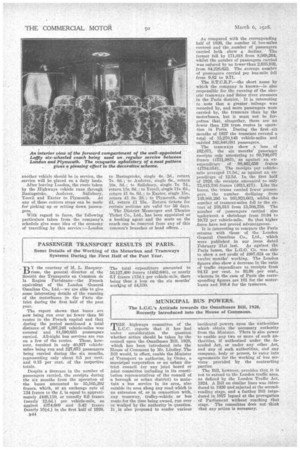PASSENGER TRANSPORT RESULTS IN PARIS.
Page 70

If you've noticed an error in this article please click here to report it so we can fix it.
Some Details of the Working of the Motorbus and Tramways Systems During the First Half of the Past Year.
BY the courtesy of M. L. Bacqueyrisse, the general director of the Socike, des Transports en Commun dc la Region Parisienne—the French equivalent of the London General Omnibus Co., Ltd.—we are able to give some interesting details of the running of the motorbuses in the Paris district during the first half of the past year.
The report shows that buses are now being run over no fewer than 86 routes in the French capital and that (luring the period mentioned a total distance of 8,397,246 vehicle-miles was covered and 81,590,633 passengers carried. All-night bus services are run on a few of the routes. These, however, resulted in only 40,977 vehiclemiles being run and 127,673 passengers being carried during the six months, representing only about 0.5 per cent. and 0.15 per cent. of the respective totals.
Despite a decrease in the number of passengers carried, the receipts during the six months from the operation of the buses amounted to 55,565,292 francs, which, at an exchange rate of 124 francs to the 1, is equal to approximately £448,110, or roundly 6.6 francs (nearly •12.8d.) per vehicle-mile, as against £374,609 and 5.42 francs (nearly 101d.) in the first half of 1926.
844 The total expenditure amounted to 56,127,490 francs (1452,640), or nearly 6,7 francs (13(1.) per vehicle-mile, there being thus a loss on the six months' working of 14,530.
. As compared with the corresponding half of 1926, the number of bus-miles covered and the, number of passengers carried both show a decline. ' The former fell by 171,018 from 8,568,264, whilst the number of passengers carried was reduced by no fewerthan 2,635,939, from 84,226,622. The .average number of passengers carried per bus-mile. fell from 9.82 to 9.71.
The S.T.C.R.P.—the short name by which the company is known—is also responsible for the running of the electric tramways and Seine river steamers in the Paris district. It is interesting to note that a• greater, mileage was recorded by, and more passengers were carried by, the tramcars than by the motorbuses,' but it must not be forgotten that, altogether, there are no fewer than 128 tram routes in operation, in Paris. During the first-. six months of 1927 the tramcars covered a total of 15,270,145 vehicle-miles and carried 163,848,681 passengers.
The tramways show a loss of 162,071, the six months' passenger receipts only 'amounting to 90,766,077 francs (1,731,983); as against an exexpenditure of • 98,462,659 francs (1794,054). The receipts per vehiclemile averaged 11.5d., as against an expenditure of .1.2.5d, In the first half of 1926 the receipts amounted to only 75,815,706 francs (£611,417). Like the buses, the trams •carried fewer passengers, the number declining . from 169,801,295 to 163,913,603, whilst the number of tramcar-miles fell to the extent of 238,013 from 15,508,758. The number of passengers carried also underwent a shrinkage from 10.94 to 10.72 per vehicle-mile. So that higher ,fares have not proved advantageous.
It is interesting to compare the Paris returns with those of the London General Omnibus Co., Ltd., which were published in our issue dated February 21st .last. As against • the Paris losses, the .L.G.0: co. was able to show a net profit of £607,624 on the twelve months' working. The London figures also show a decrease in. the ratio of traffic expenditure to receipts from 94.12 per cent. to 93.98 per cent., -whereas in the case of Paris the corresponding figures. are 101 for the motorbuses and 108.4 for the tramcars.




















































































































